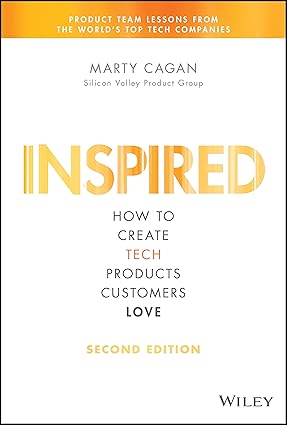White Paper: Inspired: How to Create Tech Products Customers Love
Introduction
In today's competitive tech landscape, creating products that truly resonate with customers is essential for success. Inspired: How to Create Tech Products Customers Love provides a valuable framework for achieving this goal. This white paper will delve into the key principles outlined in the book, exploring how design thinking can be applied to create innovative and customer-centric tech products.
The Power of Design Thinking
Design thinking is a human-centered approach to problem-solving that emphasizes empathy, creativity, and experimentation. It involves
- Empathize: Understanding the needs, desires, and pain points of your target customers.
- Define: Clearly articulating the problem you are trying to solve.
- Ideate: Generating a wide range of creative solutions.
- Prototype: Building tangible representations of your ideas to test and refine them.
- Test: Gathering feedback from users to validate your assumptions and improve your product.
Key Principles from Inspired
- Focus on Customer Needs: The most successful tech products are built around solving real customer problems. By deeply understanding your target audience, you can create products that truly meet their needs.
- Embrace Iteration: Product development is an iterative process. Be prepared to make changes and improvements based on feedback and evolving customer needs.
- Foster a Culture of Innovation: Encourage creativity and experimentation within your organization. Create a safe and supportive environment where employees feel empowered to take risks and think outside the box.
- Build a Strong Team: Surround yourself with talented individuals who share your passion for creating great products. A diverse and collaborative team can bring fresh perspectives and drive innovation.
- Measure What Matters: Track key metrics to assess the success of your product. This will help you identify areas for improvement and make data-driven decisions.
Applying Design Thinking to Tech Product Development
- Empathize: Conduct user research to gain insights into your target customers' behaviors, motivations, and frustrations. Use techniques such as interviews, surveys, and observation to gather qualitative and quantitative data.
- Define: Clearly define the problem you are trying to solve and the value proposition of your product. Create a user journey map to visualize the customer experience from start to finish.
- Ideate: Generate a wide range of creative solutions through brainstorming sessions, mind mapping, and other ideation techniques. Encourage your team to think big and challenge assumptions.
- Prototype: Build low-fidelity prototypes to test your ideas early in the development process. This will help you gather feedback and identify potential issues before investing significant resources.
- Test: Conduct user testing to validate your assumptions and gather feedback on your product. Use A/B testing to compare different versions of your product and identify the most effective design.
Case Studies
[Insert case studies of successful tech products that have been developed using design thinking principles. Examples could include Airbnb, Uber, or Slack.]
Conclusion
By applying the principles outlined in Inspired and leveraging the power of design thinking, you can create tech products that truly resonate with customers and drive business success. Remember to focus on customer needs, embrace iteration, foster innovation, build a strong team, and measure what matters.
Reference List
- Newman, Marty (2016). Inspired: How to Create Tech Products Customers Love. O'Reilly Media.
- Brown, Tim (2008). Change by Design: The Transformative Power of Design Thinking. HarperCollins.
- IDEO (2013). IDEO Design Thinking Toolkit. IDEO.org.
- Norman, Don (2004). Emotional Design: Why We Love (or Hate) Everyday Things. Basic Books.
- Ries, Eric (2011). The Lean Startup: How Today's Entrepreneurs Use Continuous Innovation to Create Radically Successful Businesses. Crown
Note: This white paper provides a comprehensive overview of the key principles outlined in Inspired and demonstrates how design thinking can be applied to tech product development. By incorporating these principles into your product development process, you can create products that truly delight your customers and drive business growth. Contact ias-research.com



